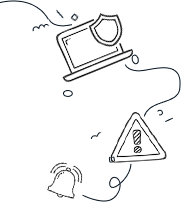Introduction
Did you know?
94% of all malware is delivered via email.
Yes, that’s right! Email is the pizza delivery of the cyber world, but instead of pepperoni, it delivers… malware. Extra greasy, of course!
Why is that? What makes email platforms so incredibly attractive to malware distributors? Grab your detective hats, and let’s investigate this digital whodunit together!
Why Do Cybercriminals Prefer Email?
Email is practically everywhere! It’s like the air we breathe—everyone has at least one email account, often more. With billions of email accounts fluttering around like digital butterflies, attackers have a veritable buffet of targets.
Why bother? Crafting and sending malicious emails is easier than baking cookies, and just like those cookies, a little can go a long way. Cybercriminals can disseminate their nefarious messages to countless unsuspecting folks with the effort it takes to click “send.”
To up their game, they often impersonate trusted brands or individuals, making their emails look like they’ve come straight from your favorite tech giant or even Aunt Edna! It’s easy to see why people are tempted to click on those deliciously deceptive links.
This flexibility allows attackers to bring out their crafty toolbox, which includes:
- Malicious attachments (think Word documents, PDFs, and executables pretending to be kittens)
- Links to infected websites that are basically cyber landmines
- HTML emails that can execute scripts—perfect for when you need a side of malware with your email!
- Spoofed sender addresses that look more legitimate than your last paycheck!
Email is simply the delivery method that bad actors use to sprinkle their chaos around!
Weaknesses in Email Platforms
These online mail systems come with their own set of vulnerabilities—like a house without a lock! Today’s email-based malware attacks are getting smarter, just like your average cat who knocks things off tables—they discover new techniques daily!
Some common technical hiccups include:
- Complex email protocols with more exploitable points than a refrigerator in a college dorm.
- Challenges in real-time verification of sender authenticity—because who has time for due diligence?
- Difficulty in comprehensively scanning all attachments and links—like searching for a needle in a haystack of spam!
- Legacy email systems that are older than your grandma’s favorite punchlines.
- Traditional security filters that can’t handle multi-stage attacks—like a security guard who’s just too cozy in their chair.
While email is a vital communication tool, it’s also a potential security risk that needs constant vigilance. Think of it as a cat that needs to be watched carefully or it may knock over your most prized plant!
The Allure of Social Engineering
Many successful attacks exploit our quirks, like curiosity or that burning need to know who “liked” your last Instagram post. Phishing emails play off those instincts, tricking you into clicking malicious links or downloading suspicious attachments—as if they were the last slice of pizza at a party!
Emails are especially effective for social engineering. Cybercriminals can conjure messages that:
- Seem to be straight from trusted sources, like your bank or that very friendly colleague who always borrows your stapler.
- Create a sense of urgency, making it feel like it’s now or never—like a sale on toilet paper.
- Exploit our emotions, triggering feelings like fear, curiosity, or mild panic—kind of like when you realize you’ve worn mismatched socks all day!
- Force us into hasty actions—clicking on links or downloading things faster than we can say “What did I just do?”
Sending mass email campaigns is like throwing confetti at a party. It’s incredibly cheap and now, thanks to automated tools, cybercriminals can launch thousands of emails for less than the price of your last coffee!
To fight back against email-based attacks, we need equally formidable tricks up our sleeves! This means using encrypted communication platforms for sensitive data, implementing multi-factor authentication (because one password is so last season), and diving into your yearly cybersecurity awareness training as if it were the latest blockbuster movie. A good understanding of these threats will keep you skeptical of suspicious messages and help maintain robust security practices.
Conclusion
Despite ongoing education efforts, many users still fall for phishing scams and other email-based attacks. Let’s face it, some people wouldn’t recognize a phishing email even if it came with a flashing neon sign. This lack of awareness keeps email a valuable asset for cybercriminals.
Understanding these factors can help us build stronger defenses against email-based threats. Regular training, robust email security solutions, and just a hint of skepticism can go a long way in shielding ourselves from these attacks.
Reading this blog is a great first step toward better cyber-hygiene each and every day! So pat yourself on the back, you tech-savvy explorer!





